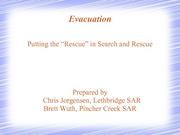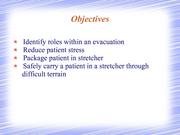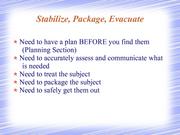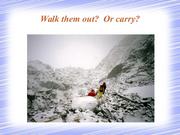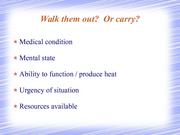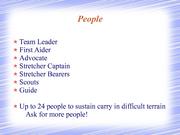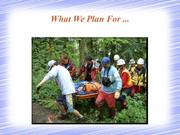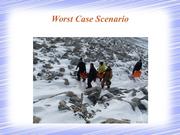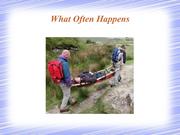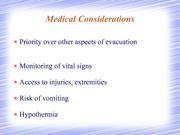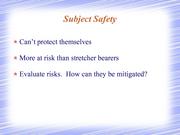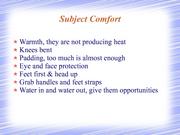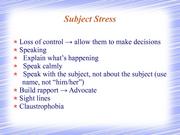SAR Fundamentals/Evacuation
From PCSAR
| Line 12: | Line 12: | ||
: SAR Fundamentals Manual: Ch.26 "Evacuation" | : SAR Fundamentals Manual: Ch.26 "Evacuation" | ||
: Basic SAR Skills Manual: Ch.23 "Rescue and Evacuation" | : Basic SAR Skills Manual: Ch.23 "Rescue and Evacuation" | ||
| - | : | + | : include litter carry / patient packaging |
== Prerequisites == | == Prerequisites == | ||
| Line 19: | Line 19: | ||
== Objectives == | == Objectives == | ||
At the conclusion of this lesson the participants: | At the conclusion of this lesson the participants: | ||
| - | # | + | # can identify roles within an evacuation |
| + | # can reduce patient stress | ||
| + | # can package patient in stretcher | ||
| + | # can safely carry a patient in a stretcher through terrain difficulties | ||
== Time Plan == | == Time Plan == | ||
| - | Total Time: | + | Total Time: 45 minutes |
* 2013-02: 25 min | * 2013-02: 25 min | ||
| Line 28: | Line 31: | ||
{{lesson slides start}} | {{lesson slides start}} | ||
{{lesson slide|00:00|3 min}} | {{lesson slide|00:00|3 min}} | ||
| + | [[Image:SAR Basics Evacuation.pdf|page=1|thumb]] | ||
| + | [[Image:SAR Basics Evacuation.pdf|page=2|thumb]] | ||
| + | |||
Introduce topic title | Introduce topic title | ||
| Line 33: | Line 39: | ||
Present Objectives | Present Objectives | ||
| - | {{lesson slide|00:03|}} | + | # can identify roles within an evacuation |
| - | + | # can reduce patient stress | |
| + | # can package patient in stretcher | ||
| + | # can safely carry a patient in a stretcher through terrain difficulties | ||
| + | {{lesson slide|00:03|3 min}} | ||
| + | [[Image:SAR Basics Evacuation.pdf|page=3|thumb]] | ||
| + | Roles in Evacuation | ||
| + | |||
| + | inner circle (medical) vs. outer circle (rescue) | ||
| + | |||
| + | * team leader | ||
| + | * first aider | ||
| + | * advocate | ||
| + | * stretcher bearers | ||
| + | * route finder | ||
| + | |||
| + | Additional resources will be sent in | ||
| + | * up to 24 people required to sustain carry of stretcher in difficult terrain | ||
| + | |||
| + | {{lesson slide|00:06|2 min}} | ||
| + | [[Image:SAR Basics Evacuation.pdf|page=4|thumb]] | ||
| + | Medical Considerations | ||
| + | |||
| + | * take priority over most other aspects of evacuation | ||
| + | * continuing monitoring of vital signs | ||
| + | * access to injuries and extremity | ||
| + | * risk of vomiting | ||
| + | * hypothermia | ||
| + | |||
| + | {{lesson slide|00:08|2 min}} | ||
| + | [[Image:SAR Basics Evacuation.pdf|page=5|thumb]] | ||
| + | Subject Safety | ||
| + | |||
| + | * can't protect themselves | ||
| + | * situations that may be safe for the stretcher bearers may not be safe for the subject | ||
| + | ** e.g. a slip, might mean stretcher bearer catches themselves with hands, subject has unprotected fall | ||
| + | * what are the risks? how likely are they? how serious are they? how can they be mitigated? | ||
| + | |||
| + | {{lesson slide|00:10|3 min}} | ||
| + | [[Image:SAR Basics Evacuation.pdf|page=6|thumb]] | ||
| + | Subject Stress | ||
| + | |||
| + | * very scary being the subject | ||
| + | * losing control | ||
| + | * calm voices, no shouting, listening, not talking at the same time, avoid side conversations | ||
| + | ** even if unconscious | ||
| + | * build rapport with subject, patient advocate | ||
| + | * use subject's name, introduce yourself, talk to subject | ||
| + | * engage subject in their own care | ||
| + | * sight lines, generally move feet first | ||
| + | * avoid lights in eyes | ||
| + | * dust, dirt, debris | ||
| + | ** lower down, face up, more exposed | ||
| + | ** safety glasses, face shield, clear plastic sheet | ||
| + | * claustrophobia | ||
| + | ** arms in/out of packaging | ||
| + | |||
| + | {{lesson slide|00:13|2 min}} | ||
| + | [[Image:SAR Basics Evacuation.pdf|page=7|thumb]] | ||
| + | Subject Comfort | ||
| + | |||
| + | * pressure sores (can become medical issue) | ||
| + | ** more issue for SAR than other training (longer periods) | ||
| + | ** thermarest | ||
| + | ** packing voids | ||
| + | ** Padding, too much is almost enough | ||
| + | * hydration | ||
| + | * excretion | ||
| + | |||
| + | {{lesson slide|00:15|3 min}} | ||
| + | [[Image:SAR Basics Evacuation.pdf|page=8|thumb]] | ||
| + | Types of Stretchers | ||
| + | |||
| + | * wire basket stretcher (e.g. Stokes) | ||
| + | * polyethylene basket stretcher (ferno) | ||
| + | * two piece polyethylene basket stretcher | ||
| + | * attachable wheel | ||
| + | * mountain stretcher (e.g. Mariner) | ||
| + | * field litter | ||
| + | |||
| + | {{lesson slide|00:18|10 min}} | ||
| + | [[Image:SAR Basics Evacuation.pdf|page=9|thumb]] | ||
| + | [[Image:SAR Basics Evacuation.pdf|page=10|thumb]] | ||
| + | Order of Packaging - No backboard | ||
| + | |||
| + | ''demonstrate packaging'' | ||
| + | |||
| + | * stretcher | ||
| + | * burrito lashing laid out | ||
| + | * tarp open | ||
| + | * sleeping bag (open) | ||
| + | * thermarest (deflated) | ||
| + | * empty pockets | ||
| + | * patient | ||
| + | * pad hollows (neck, small of back, under knees, between legs) | ||
| + | * environmental protection | ||
| + | ** close sleeping bag | ||
| + | ** add blankets | ||
| + | ** space blanket -- condensation issue | ||
| + | ** fold tarp | ||
| + | ** tie burrito lashing | ||
| + | ** inflate thermarest | ||
| + | * stretcher lashing | ||
| + | ** cross at chest, cross at hip, above knees, below knees | ||
| + | * faceshield / sunglasses | ||
| + | |||
| + | {{lesson slide|00:28|3 min}} | ||
| + | [[Image:SAR Basics Evacuation.pdf|page=11|thumb]] | ||
| + | Complex Packaging | ||
| + | |||
| + | spinal restrictions | ||
| + | * advanced or wilderness first aid skill | ||
| + | * thermarest goes between patient and backboard | ||
| + | |||
| + | rope rescue | ||
| + | * needed for >15° slope or unstable terrain | ||
| + | * improvised harness goes on patient | ||
| + | * stretcher lashing is more complicated | ||
| + | |||
| + | People with these higher level skills will be brought in to work with | ||
| + | you on packaging | ||
| + | |||
| + | {{lesson slide|00:31|6 min}} | ||
| + | [[Image:SAR Basics Evacuation.pdf|page=12|thumb]] | ||
| + | Carrying | ||
| + | |||
| + | * similar height on opposite sides | ||
| + | * Carry the litter level or, if not possible, head high unless medical control suggests otherwise | ||
| + | * use of webbing over outside shoulder | ||
| + | ** don't tie yourself in | ||
| + | * safe lifting practice | ||
| + | ** don't take stretcher bearer role if bad back, shoulder, wrist | ||
| + | ** Lift with your legs (not your back) | ||
| + | * lift/lower called by person at head | ||
| + | ** "on my call, we will lift" | ||
| + | ** "anyone not ready?" (ask in the negative) | ||
| + | ** "one, two, lift" | ||
| + | * anyone can call a break | ||
| + | |||
| + | ''exercise: short carry and lower'' | ||
| + | |||
| + | {{lesson slide|00:37|7 min}} | ||
| + | [[Image:SAR Basics Evacuation.pdf|page=13|thumb]] | ||
| + | Moving | ||
| + | |||
| + | ''exercise: resume the carry, adding complications of terrain to bring out the following points'' | ||
| + | |||
| + | * Use of scout | ||
| + | * relief comes in from front | ||
| + | ** exchange sides to relieve your tired arm | ||
| + | ** pass forward | ||
| + | * obstacles/difficult terrain, stand still with firm footing and pass forward | ||
| + | * subject is vomiting | ||
| + | ** place on ground and lift one side to near vertical | ||
| - | + | {{lesson slide|00:37|1 min}} | |
| + | Questions | ||
| + | [[Image:SAR Basics Evacuation.pdf|page=14|thumb]] | ||
{{lesson slides end}} | {{lesson slides end}} | ||
| Line 47: | Line 207: | ||
** 1 x 10+m or 2 x 7m | ** 1 x 10+m or 2 x 7m | ||
* improvised terrain or obstacles | * improvised terrain or obstacles | ||
| + | * {{link|Image:SAR Basics Evacuation.odp}} ({{link|Image:SAR Basics Evacuation.pdf|pdf}}) | ||
* {{link|Image:SAR Fund CJ Evacuation.pdf}} | * {{link|Image:SAR Fund CJ Evacuation.pdf}} | ||
| + | * [[Training/Ideas/First aid]] | ||
| + | * {{link|Image:Members:A Short History of Stretchers.pdf}} | ||
| + | <gallery> | ||
| + | Image:Members:Folding Military Field Litter.jpg | ||
| + | </gallery> | ||
== Question bank == | == Question bank == | ||
| Line 64: | Line 230: | ||
Recommended license below. Fill in the year and the author's name(s): | Recommended license below. Fill in the year and the author's name(s): | ||
| - | Copyright © | + | Copyright © 2013-2015, Chris Jorgensen, Brett Wuth. |
This work is licensed under a | This work is licensed under a | ||
Creative Commons Attribution-NonCommercial 2.5 Canada License. | Creative Commons Attribution-NonCommercial 2.5 Canada License. | ||
Revision as of 16:08, 12 March 2016
Contents |
Subject
What is this lesson plan about?
Moving the subject after they have been located.
Authors
List who wrote this lesson plan.
Scope
What is included in this lesson, what's not and why.
- SAR Fundamentals Manual: Ch.26 "Evacuation"
- Basic SAR Skills Manual: Ch.23 "Rescue and Evacuation"
- include litter carry / patient packaging
Prerequisites
What should students already know/have accomplished before the lesson is presented.
Objectives
At the conclusion of this lesson the participants:
- can identify roles within an evacuation
- can reduce patient stress
- can package patient in stretcher
- can safely carry a patient in a stretcher through terrain difficulties
Time Plan
Total Time: 45 minutes
- 2013-02: 25 min
add details about packaging
| Time | Material
|
|
00:00 3 min |
Introduce topic title Introduce Instructor Present Objectives
|
|
00:03 3 min |
Roles in Evacuation inner circle (medical) vs. outer circle (rescue)
Additional resources will be sent in
|
|
00:06 2 min |
Medical Considerations
|
|
00:08 2 min |
Subject Safety
|
|
00:10 3 min |
Subject Stress
|
|
00:13 2 min |
Subject Comfort
|
|
00:15 3 min |
Types of Stretchers
|
|
00:18 10 min |
Order of Packaging - No backboard demonstrate packaging
|
|
00:28 3 min |
Complex Packaging spinal restrictions
rope rescue
People with these higher level skills will be brought in to work with you on packaging
|
|
00:31 6 min |
Carrying
exercise: short carry and lower
|
|
00:37 7 min |
Moving exercise: resume the carry, adding complications of terrain to bring out the following points
|
|
00:37 1 min |
Questions |
Aids
What materials are needed or useful in presenting this lesson.
- non-publishable material
- wire mesh stretcher
- webbing
- 6 x 5m
- 1 x 10+m or 2 x 7m
- improvised terrain or obstacles
- Image:SAR Basics Evacuation.odp (pdf)
- Slide show for Evacuation Lesson by Chris Jorgensen
- Training/Ideas/First aid
- Image:Members:A Short History of Stretchers.pdf
Question bank
List of questions suitable for an review/exam of this section.
See Question bank
Frequently Asked Questions
What are some of the questions that students typically ask. Include the answers.
Feedback
When has this lesson been presented. What was the feedback.
License
What can others do with this lesson?
Recommended license below. Fill in the year and the author's name(s):
Copyright © 2013-2015, Chris Jorgensen, Brett Wuth. This work is licensed under a Creative Commons Attribution-NonCommercial 2.5 Canada License. To view a copy of this license, visit http://creativecommons.org/licenses/by-nc/2.5/ca/ or send a letter to Creative Commons, 559 Nathan Abbott Way, Stanford, California 94305, USA.
Reference Material
If you need to cite sources, do so here.
[1]
Notes
Any additional notes, etc.
